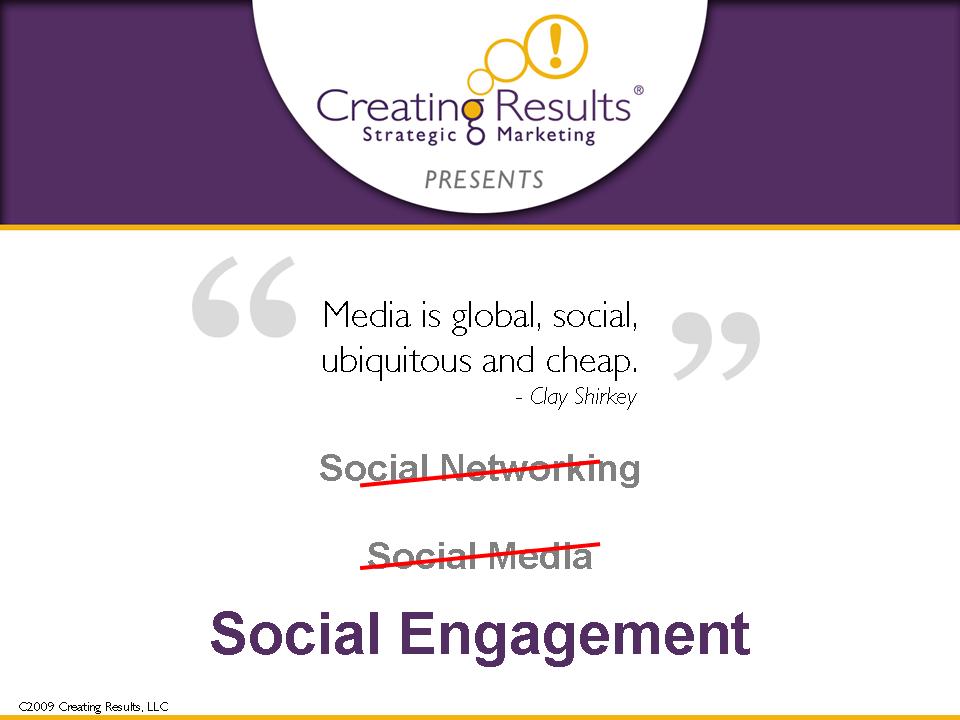“One size communication does not fit all,” commented Kevin Baughen on this blog earlier this week. “None of us should be treating different audiences as if they are one homogeneous group.”
Kevin, a marketer based in Surrey, UK, was responding to the findings we shared about generations and their interaction/support of charities. And he was talking about the need to see that individual members of Gen X, the Baby Boom or the Silent Generation are truly individuals. Better to ask for and respect their individual preferences than assume that one way is the only way for everyone in a cohort. This is a philosophy that Creating Results shares.
But Kevin could easily have been talking about the members of different types of audiences, the regional and national groups I speak to on a regular basis.
For example, last week I made a presentation on “Social Media: Risk and Rewards” to the members of The Coalition for Human Services (CHS) in  Prince William County, VA. (A copy of this presentation can be found on SlideShare.) The audience was made up of non-profit organizations and government agencies which serve area residents. I’ve talked about social media marketing with other audiences as well – entrepreneurs with early-stage start-ups, builders and developers, small businesses.
Prince William County, VA. (A copy of this presentation can be found on SlideShare.) The audience was made up of non-profit organizations and government agencies which serve area residents. I’ve talked about social media marketing with other audiences as well – entrepreneurs with early-stage start-ups, builders and developers, small businesses.
Each time I present this “Social Media 101” program, I find there is a wide range of ages represented. And a wide range of experience and comfort with social media. The CHS audience included:
• Mark Bergeron with Northern Virginia Family Services, whose organization is actively using Facebook and YouTube to campaign for a grant from Pepsi. (Vote for NVFS! http://www.refresheverything.com/nvfs)
• Betty Dean of Didlake, Inc., which connects people with disabilities to training and business opportunities. Didlake hasn’t established a corporate presence on any of the social networks, but they are working on it. In the mean time, they have been encouraging team members to post updates on fundraising via Facebook. Their last resulted 17% of web site traffic to come in through Facebook.
• Several folks who confessed they are afraid of setting up an account on Facebook because they believe (incorrectly) they’ll have to provide their social security number.
• And staffers from a senior center who worry that their clients will become victims of identity theft if they become active on social networks. (Personally, I see that as patronizing. Why would seniors suddenly begin to overshare online? In fact, studies have shown that elders are typically LESS likely to fall victim to online scams, because they are cautious.)
One size communication indeed does not fit all. But there are some common questions among all the audience members – no matter where they fall on a spectrum of social engagement. The first is ROI. Will this investment pay off? How will they measure success? What site will give me the best “return”?
To help people understand and sort through various options, Creating Results distributed two handouts. One is a Social Media Cheat Sheet that provides descriptions and data on popular Social Media websites. The second is a Social Media Survival Guide that lays out a five step program for becoming socially engaged. See Related Links, below.
Another frequent question is personal responsibility. At the CHS luncheon, we had a lively conversation about the blurry boundaries between your activities as an individual on the social Web and if or how you represent your organization.
Didlake isn’t the only group asking staff, volunteers or even donors to be “foot soldiers” in the battle for attention of social media users. When you’re depending on others to carry your message, how much control can you exert? Should you even try? Where is the boundary between your personal social media presence and your professional one? Please share your comments/thoughts below.
P.S. Many of the attendees asked for guidelines or help with social media policies. Public Relations expert Mark Ragantweeted this week about a new tool: http://socialmedia.policytool.net/. It is supposed to help generate policies that “respect the rights of your employees while protecting your brand online.” If you try it, let us know what you thought.
RELATED LINKS:
Social Media Survival Guide – a 5 step, scale-up action plan for getting started with social media marketing. Updated October 2012



